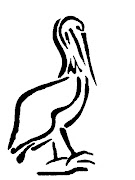That's fine, but where a permanent loop is required, a splice is far more professional and proper. The new braided lines take a lot of work to splice and requires special tools in the form of hollow fids. But three strand nylon line - that of the most common dock, anchor, and snubber lines - is spectacularly easy to splice. Eye, end, and long/short splices are quite easy to do and once one is known, the rest are easily mastered.
 In my reading about chain anchor rode I found that leaving the stress of anchoring on the bow rollers is considered bad form - the roller isn't designed for that kind of stress and the capstan, if your boat is so equipped, shouldn't be trusted to hold the strain. The solution, of course, exists in the form of snubber lines typically made of three strand nylon.
In my reading about chain anchor rode I found that leaving the stress of anchoring on the bow rollers is considered bad form - the roller isn't designed for that kind of stress and the capstan, if your boat is so equipped, shouldn't be trusted to hold the strain. The solution, of course, exists in the form of snubber lines typically made of three strand nylon.Snubber lines are deployed by hooking to the chain outboard of the bow roller and led through the bow chocks or hausepipes to the bow cleats. More chain is deployed until the strain is taken up by the snubber lines. Finally, the capstan is locked as a precaution.
This arrangement, although a bit more of a task to deploy, will help the boat ride more calmly at anchor (especially if your vessel has a tendency to sail about the anchor) and provides three points of failure.
There is another benefit to this arrangement: You can take one of the snubbers aft to another point to help the boat ride more smoothly in a crossing current/wind situation - instead of rolling with the waves, the boat can be pointed into or away from them.
That's why you want snubbers.
For a very nice manual for splicing, check this out: http://www.gleistein.com/en/files/Splicebook_EN_short.pdf
Here's how to make them (always make two - that way normally two in the bow, but one for the stern if you're deploying that anchor).
 First, decide what size line - for my 42 foot boat, I chose 5/8ths inch line - I could have gone to 3/4ths but that would have made them to hard to manage.
First, decide what size line - for my 42 foot boat, I chose 5/8ths inch line - I could have gone to 3/4ths but that would have made them to hard to manage.Purchase the appropriately sized thimbles and shackles. The hook is a bit more difficult as you have to make sure it fits your chain. Just so you know, there's about a dozen chain sizes in the range we'd use. Mine are 5/16ths with short links - I think high tensile chain. The point is, get the right size hook.
I decided to make mine about 28 feet long. Normally, you'd only use about 10 feet, but better too long than too short. Also, the line can be an extra dock line or tow line or a lifting line.
I put an eye splice on one end large enough to go over my cleats and all the hardware on the other end.
Once you can do an eye splice properly, it should take you about half an hour to make an entire snubber. Don't worry if it takes longer. The more splicing you do, the faster it gets.
I make my own dock lines. Sure, you can purchase them. But can you purchase them exactly the right length? Or with an eye on one end and an end splice on the other? Or two eyes? Whatever you think you need or want, you can make.
Personally, for dock lines, I believe they all should be the length of the boat. If you have custom spring, bow, and stern lines then you have to sort them all out when docking. If they're all the same, it doesn't matter which one you take forward. One line can be a bow or stern and spring line. It's better to sort out the lengths after you're safely docked than when you're in the middle of docking.
Others disagree. But I dock my Pearson 424 alone so this is what works for me.
There is something else to making your own lines: You'll garner awe from other boaters who have no idea how to do it. Here's something to try: work on splicing on deck while at a marina. You'll be surprised at how many people will come over to see what you're doing and exclaim amazedly at your ability to splice!
So - make some snubbers if you use chain rode. Learn how to splice - it's a wonderful skill and fun to do. When you learn it, you can pass on the skills.
It's March today! The season's almost here! Woohoo!
I can't wait to see you on the water!


1 comment:
Always good info Capt Bob, thanks
Post a Comment